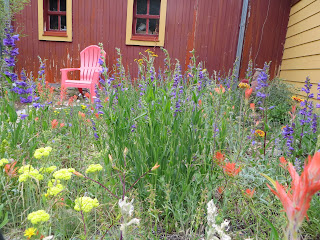 The Aztecs cultivated the poinsettia in Mexico long before Europeans came to the Western Hemisphere. They used the bracts for a reddish-purple dye and the latex to counteract fever. The plant also played a part in midwinter celebrations and was widely planted in gardens.
The Aztecs cultivated the poinsettia in Mexico long before Europeans came to the Western Hemisphere. They used the bracts for a reddish-purple dye and the latex to counteract fever. The plant also played a part in midwinter celebrations and was widely planted in gardens. In 1925, Joel R. Poinsett, a botanist and the first U.S. Ambassador to Mexico, sent some plants to his home in South Carolina. He shared his find with other plant enthusiasts. December 12th is National Poinsettia Day and recognizes Poinsett’s contribution to the holiday season.
Poinsettias do well in the home and keep their color until mid-March. The showy red, pink, white, yellow, bicolored or speckled modified “leaves” are called bracts. With proper light and temperature, they accumulate the pigments that give them their color. The flowers of the poinsettia are in the center of the bracts.
Poinsettias come in many colors and forms. New selections appear every year. When selecting a plant, choose one with dark green foliage. However, cultivars with lighter colored bracts typically have lighter green foliage.
Plants with pale green, yellow or fallen leaves generally have a root disease problem, have been overwatered, had an excessive dry period, or received limited fertilization. Bracts should be well-developed with little pollen showing on the flowers at the center of the bracts.
When outside temperatures approach 35 degrees F, be sure the plant is well wrapped or sleeved before transporting. Low temperatures, even for short periods, can damage leaves and bracts.
To care for your new poinsettia, place it where it can receive a lot of indirect sunlight. Poinsettias thrive on indirect, natural daylight–at least six hours per day. Avoid direct sunlight, as this may fade the bract color. To prolong color, keep plants out of cold drafts and away from excessive heat. Ideal temperatures are 67 to 70 degrees F during the day and 60 to 62 degrees F at night. Remove damaged or diseased leaves.
Poinsettias require moderately moist soil. Check plants daily and water thoroughly whenever the soil feels dry to the touch. Plants in clay pots require more water, while those in plastic pots are easily overwatered. Do not allow the plants to sit in standing water. You may need to remove foil wraps or poke holes in it to allow for water drainage.
A poinsettia does not require fertilization while it is in bloom. However, to maintain green foliage and promote new growth, apply a balanced all-purpose house plant fertilizer once a month. Always follow the directions on the fertilizer label.













